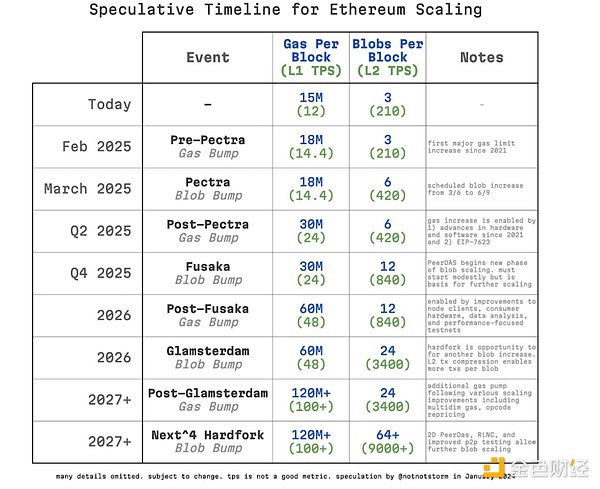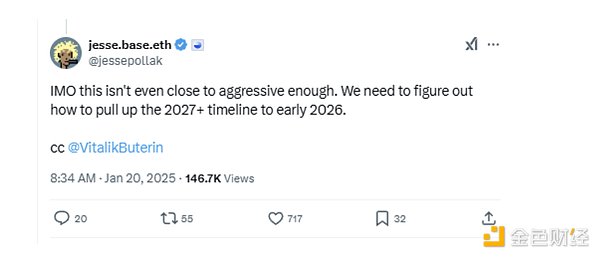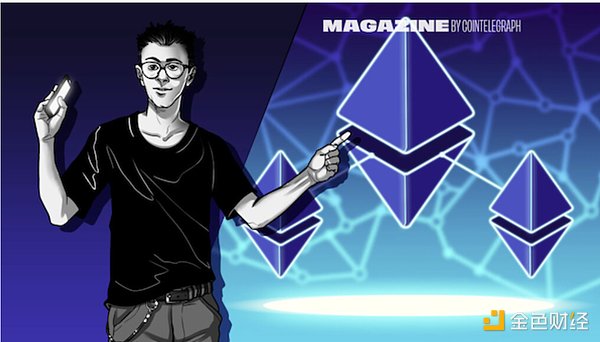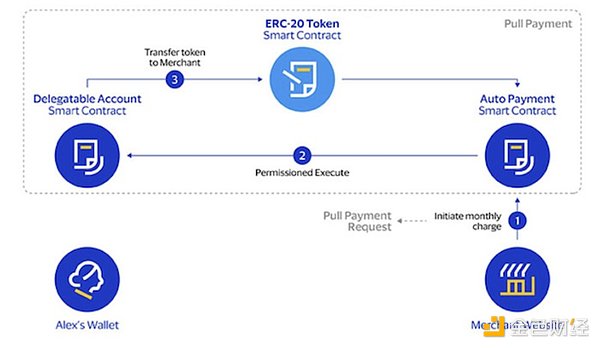Author: Andrew Fenton Source: cointelegraph Translation: Shan Ouba, Golden Finance
Confused by the technical terms of the Pectra hard fork explained by the developers? We interpret these upgrades for you in the language of ordinary people.
Recently, Ethereum's scaling roadmap has been criticized by all parties, and even ETH researcher Dankrad Feist and Base founder Jesse Pollak believe that the existing expansion plan is "lacking ambition" and even "far from radical enough".
However, the community's doubts seem to ignite the fighting spirit of some core figures.
Last weekend, Ethereum founder Vitalik Buterin published a new article, calling for an accelerated expansion roadmap and rapidly increasing the current Data Availability Blobs (DA Blobs) per block from 3 to 128 and above.
L2 (Layer 2) networks rely on Blobs to store data, and the more Blobs there are, the lower the cost of L2 growth. Therefore, accelerating expansion is crucial to the entire Ethereum ecosystem.
Meanwhile, crypto investment company Paradigm also released a proposal, which roughly means: "Stop dragging your feet and launch the expansion upgrade!"
On the other hand, L2 leaders such as Base, Arbitrum and Optimism have also reached a consensus that they should unify ecological standards and adopt universal or native Rollup solutions in their respective projects.
So, how much expansion improvement can Ethereum's upcoming Pectra upgrade (expected to be implemented in March) bring? What new features will it introduce for ordinary users? Let's find out.

Pectra upgrade is divided into two parts
Originally, the Pectra hard fork was planned to be the largest upgrade in Ethereum history, including up to 20 EIPs (Ethereum Improvement Proposals). But now, the upgrade has been split into two parts.
Thus, Pectra only provides temporary relief for scaling issues, with its main improvement being to increase the number of data availability blobs from 3 to 6, providing only short-term relief for scaling needs.
Consensys head of research Mallesh Pai noted that “six months ago, the ‘double blobs’ option wasn’t even on the roadmap”, but even so, the upgrade still couldn’t meet the growing demands of L2 networks.
"Based on the current growth rate of L2, the effect of this upgrade can only last until the end of this summer at most." - Mallesh Pai
The good news is that the Fusaka hard fork is expected to be implemented later this year or early next year, which includes a key upgrade:
Peer Data Availability Sampling (PeerDAS) - This will become the most important change in Ethereum's expansion, and Vitalik Buterin also hopes that the entire community will focus on this.
PeerDAS: Torrent for Blobs
PeerDAS is the next evolution of "Proto-Danksharding" technology, which allows L2 to store data in Blobs to avoid competing with L1 transactions for block space.
However, EIP-4844 still requires full nodes to download all Blobs of the entire block and verify the integrity of the data therein.
This is extremely inefficient and a burden on small node operators. Downloading blobs (or even broadcasting blobs in the case of proposers) consumes a lot of bandwidth.
--Emmanual Awosika (Head of Research at 2077 Collective)
PeerDAS optimizes the way blobs are stored and verified, splitting them into smaller data chunks, similar to P2P seed downloads (Torrent), allowing different nodes to store and access only part of the data instead of downloading complete blobs.
Vitalik expects that PeerDAS will immediately increase the number of blobs by 2 to 4 times, and even 8 times or more in the future.
Just last week, Base founder Jesse Pollak criticized the slow progress of Ethereum's existing roadmap and said that the expansion goal originally scheduled for 2027 should be brought forward to 2026.
But if Vitalik's prediction is correct, then PeerDAS may increase the number of Blobs to 48/Slot within the next year, greatly accelerating the expansion of Ethereum.


However, the improvements brought by the Pectra upgrade are not just doubling the number of blobs, Awosika pointed out that there are two key changes:
He said both changes were "major breakthroughs."
In addition, there is a much-discussed proposal EIP-7623, which has not yet been determined whether it will be included in the upgrade.
“If EIP-7623 is finally implemented, it will be possible to further increase the Gas Limit in the future - this will be a major breakthrough. As for other improvements, it is more about optimization and iteration.”
——Emmanual Awosika
The reason why Ethereum's expansion roadmap has suffered a lot of bearish sentiment is largely because:
Developers and researchers used a lot of complex terms and technical concepts when explaining, which made it impossible for most people to understand the actual impact of these upgrades.
Therefore, we tried our best to translate the key content of the Pectra upgrade into a language that ordinary investors can understand, so that everyone can truly understand the significance of this upgrade.

Everyone has a Smart Account (EIP 7702)
The biggest usability improvement implemented by Pectra is EIP-7702, which allows existing Ethereum accounts to be upgraded to Smart Accounts (also known as "account abstraction") with just a single click.
This will finally solve the long-standing problem of needing to sign two transactions in Ethereum: "approval" and "exchange".
It also supports “social recovery, native multi-signature, and a variety of other features that allow us to bring a ton of new value and experiences directly to users,” Pai said.
If all this sounds familiar, that’s because Smart Accounts were launched on Ethereum back in early 2023 with the brilliant success of ERC-4337. However, it was a workaround to avoid a hard fork that required users to go through the painful process of launching a new wallet. At its peak, around 3.5 million wallets used it.
John Rising of smart account platform Stackup explained: “Broad adoption was held back by one key limitation: users couldn’t upgrade their existing wallets to Smart Accounts.”
Incredibly, Pai said, it took Buterin less than an hour to come up with a more elegant solution in Pectra.
“I know he was on a safari in Kenya, in a truck […] and came up with a route that everyone could follow and do. So, yeah, he’s amazing.”
Rising said that by allowing existing wallets to simply upgrade, “we are removing the last major barrier to mainstream adoption of account abstraction.”
“The features we take for granted in traditional finance — automatic payments, account recovery, merchants covering transaction fees — can finally become standard in Web3,” he said.
“We’ll see subscription services that don’t require pre-approval, gas fees that are paid in any token, biometric security that replaces seed phrases, autonomous agents that run securely inside wallets, and seamless cross-chain interactions.”
While this all sounds great, complex smart account features are relatively expensive on L1. However, once EIP-7702 goes live on L2, smart account features can run seamlessly between the two.

Increase in validator stake limit (EIP-7251)
A major improvement for the health of the network itself is to increase the maximum stake limit for validators from 32 ETH to 2048 ETH.
Currently, if you are lucky enough to have 2048 ETH and want to stake it all, you need to run 64 independent validators. Given that the same person controls ETH, this puts 64 times more pressure on the network than is actually necessary, without much gain in decentralization.
“The resulting network overhead (every validator has to sign blocks, signatures have to be aggregated, etc.) degrades the performance of the entire network,” Pai explained.
Awisoka said the beacon chain would collapse if millions of validators tried to join it, so raising the limit is a smart move. “This removes one of the root reasons why companies like Lido and Coinbase run so many validators with so few node operators.”
Reducing network overhead has other benefits as well. “This upgrade unlocks other much-needed upgrades like single-slot finality,” Awosika said. Single-slot finality allows blocks to be proposed and finalized in 12 seconds (rather than 15 minutes), meaning transactions can be confirmed almost instantly. “SSF is a big barrier to Rollup interoperability,” he said.
Blob Target to Double
As mentioned before, the blob target is increasing from 3 to 6 per block to help L2 scale. The maximum number of blobs was already 6, but every time L2 posted more data than the target, fees would spike and L2 became uneconomical.
“This has happened several times this month. Pectra increased the number of blobs per block to a maximum of 9, with a target average of 6. So this is effectively a 100% increase,” Pai explained.
That being said, increasing the number of blobs faster comes at the cost of increasing the block size and imposes higher bandwidth requirements on Ethereum solo stakers. The higher the requirements, the fewer solo stakers there are.
“The trade-offs between the needs of Ethereum’s L2 and its core value of decentralization will be a key theme for developers over the coming year,” he said.
Separately, validators have been calling for a gas target increase to 36 million per block, which would help scale Ethereum’s base layer. It would not require a hard fork and would likely be enabled as soon as the vote reaches 51%.
Blobs could increase further (EIP-7623)
EIP-7623 is under consideration but has not yet been confirmed for the Pectra upgrade. The proposal could increase the number of blobs per block to 18 by repricing call data, the original method of storing data on Ethereum.
If they do implement EIP-7623, then further increases in the gas limit are possible in the future,” Awosika said.
The proposal essentially increases the gas cost of transactions that use a lot of call data to incentivize them to use blobs instead. This makes call data and block sizes more predictable, meaning the network can safely increase the number of blobs without overloading the system.
“If you can know what the maximum block size is (meaning: trying to rollups that use call data instead of blobs won’t blow up blocks), then I think you can add more blobs with more confidence,” Awosika explained.
Withdrawing from Ethereum Delegated Staking Without Permission (EIP-7002)
This is another complex upgrade that will make your ETH delegated stake more secure. It both increases Lido and RocketPool’s control over malicious node operators, and increases the ability for staked ETH token holders to withdraw funds without the permission of the node operators running validators on their behalf.
Currently, you may be unable to withdraw your staked funds because you don’t have the validation key required to do so.
“This is bad for the obvious reason that someone can hold onto your funds and refuse to grant withdrawals,” Awosika said.
The new upgrade separates the validator keys used by node operators from the withdrawal keys, which are held by ETH stakers. This allows stakers to restore their balances and withdraw funds at any time. Stakers submit their request as a regular transaction, and after some technical hassles, “stakers can withdraw their staked funds after they have been sent to the withdrawal address, without operator approval.”
The upgrade also benefits pooled staking protocols like Lido and Rocketpool. “Currently, node operators funded by withdrawal addresses controlled by the DAO can refuse requests to exit validators, or intentionally commit violations to trigger slashing of staked ETH,” Awosika said.
“The protocol DAO is helpless in the current situation because these validators can only exit through the validator key controlled by the node operator. However, EIP-7002 authorizes the DAO to force exit one or more validators controlled by a malicious node operator.”

Scaling won’t happen overnight, but it will happen
Mallesh Pai believes it’s completely understandable that the community wants scaling improvements to land faster — and so does he.
“Everyone wants the upgrade to be done right away.”
“But these improvements will eventually be implemented.” ——Pai
Consensys CEO and Ethereum co-founder Joe Lubin said that Ethereum’s expansion roadmap is actually much smoother than many people think.
“I don’t think the current progress is absolutely optimal, but overall I’m very satisfied with the current development.”
“Although some people will think that some aspects are not progressing well, I think the overall situation is still on the right track.” ——Lubin
Lubin also pointed out that upgrading a public chain (Ethereum) with a market value of $400 billion requires a balance between speed and security. “We have to make sure that we don’t destroy the network because it carries a lot of value. At the same time, we also need to make sure that it is still decentralized enough for users with certain device capabilities. Therefore, this is always a trade-off that needs to be discussed.”
I personally support raising the hardware and bandwidth thresholds for Ethereum, and I think this is reasonable. As for the Pectra upgrade, Pai believes it is an important advancement that will help solve the problems that have long plagued the Ethereum ecosystem. After Pectra, the ‘interoperability’ and ‘fragmentation’ issues that have plagued users and developers will be easier to solve.
 Brian
Brian














